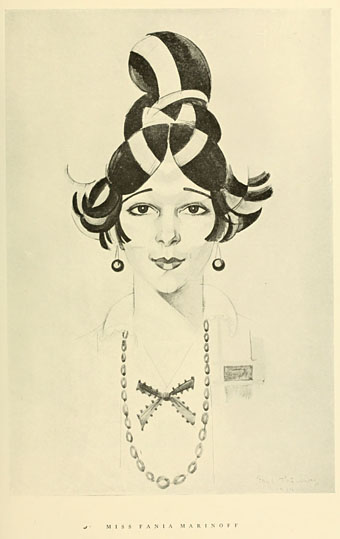

Husband Carl Van Vechten
.jpg) Fania
Marinoff (March 20, 1890 – November 17, 1971) was a Russian-born American
actress.
Van Vechten and Marinoff were known for ignoring the social separation of
races during the times and for inviting blacks to their home for social
gatherings. They were also known to attend public gatherings for black people
and even on occasion visit black friends in their homes. Although Van Vechten's marriage to Fania Marinoff, lasted for 50
years, there were often arguments between them over Van Vechten's affairs with
men.[17]
Van Vechten was known to have romantic and sexual relationships with men,
especially Mark Lutz.[11]
Fania
Marinoff (March 20, 1890 – November 17, 1971) was a Russian-born American
actress.
Van Vechten and Marinoff were known for ignoring the social separation of
races during the times and for inviting blacks to their home for social
gatherings. They were also known to attend public gatherings for black people
and even on occasion visit black friends in their homes. Although Van Vechten's marriage to Fania Marinoff, lasted for 50
years, there were often arguments between them over Van Vechten's affairs with
men.[17]
Van Vechten was known to have romantic and sexual relationships with men,
especially Mark Lutz.[11]
Fania Marinoff was born in Odessa, Russia on March 20, 1890.[1] Marinoff was born into a Jewish household, she was the thirteenth child and seventh daughter born to Mayer and Leah Marinoff, who shortly died after she was born. Nicknamed Fanny as child, Marinoff at the age of 6 was smuggled onboard an overcrowded passenger ship headed to America. Marinoff arrived in Boston where she lived undernourished and uneducated.[2] At the age of 8, Marinoff was sent to live with her older brother, Michael. While living with Michael and his wife, Marinoff was tortured on a regular basis, locking her in dark rooms infested with rats upon hours on end. A year later at the age of 8, Marinoff made her stage debut as a little boy in Cyrano de Bergerac at the El Itch Theater.[3] This launched the beginning of what would be a 50-year career.
In the year 1914, Fania Marinoff married American writer and photographer Carl Van Vechten. The two first met in the summer of 1912 in New York City through mutual friends. Shortly after meeting each other, the two quickly formed a strong bond. Within the first year together, Van Vechten told Fania that she was more than what he could have dreamed of saying she is “the only one that I have ever found who completely satisfies me.”[4] From the beginning of their relationship, Fania Marinoff was aware of Van Vechten's homosexual desires. Although Marinoff had attained great recognition before meeting Van Vechten, once married, Fania Marinoff found herself living in Van Vechten's shadow. To many she was known as simply “Carlo’s wife”.[5] The couple quickly played a prominent role in the Harlem Renaissance.[6]

Photographed by Carl Van Vechten on January 9, 1939

Carl Van Vechten with
wife, Fania Marinoff, 1922

Fania Marinoff, by Paul Thévenaz
Nella Larsen dedicated her book Passing to Marinoff and husband Van Vechten.
Marinoff played supporting and lead roles in dozens of Broadway plays between 1903 and 1937, seven U.S. silent movies between 1914 and 1917, and three short films in 1915.[7]
Marinoff was an actress and dancer for almost 50 years. Her career bloomed when she was lead actress in the Greenwich Village Players. She was well known for her movie roles in One of Our Girls (1914), The Galloper (1915) and Life's Whirlpool (1917). On stage, she played lead in the original play Karen (1918) as well as Antony and Cleopatra (1937) and Pillars of Society (1931).
During her career, she took an eight-year break because of her heavy drinking, she told an interviewer.[8] The last few years of her career she volunteered at Stage-Door Canteen entertaining troops from 1942 to 1945.[9] After retiring from acting, she and her husband Carl Van Vechten, were still quite active in artistic circles.
Marinoff died in 1971 in Englewood, New Jersey from pneumonia.[10]
My published books: